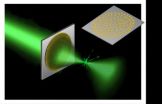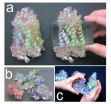(Press-News.org) The worst drought to hit the United States in at least 50 years does have one benefit: it has created the smallest "dead zone" in the Gulf of Mexico in years, says a Texas A&M University researcher who has just returned from gulf waters.
Oceanography professor Steve DiMarco, one of the world's leading authorities on the dead zone, says he and other Texas A&M researchers and graduate students analyzed the Gulf Aug. 15-21 and covered more than 1,200 miles of cruise track, from Texas to Louisiana. The team found no hypoxia off the Texas coast while only finding hypoxia near the Mississippi River delta on the Louisiana coast.
"We had to really hunt to find any hypoxia at all and Texas had none," he explains.
"The most severe hypoxia levels were found near Terrabonne Bay and Barataria Bay off the coast of southeast Louisiana.
"In all, we found about 1,580 square miles of hypoxia compared to about 3,400 square miles in August 2011. What has happened is that the drought has caused very little fresh-water runoff and nutrient load into the Gulf, and that means a smaller region for marine life to be impacted."
DiMarco has made 27 research trips to investigate the dead zone since 2003.
DiMarco says the size of the dead zone off coastal Louisiana has been routinely monitored for about 25 years. Previous research has also shown that nitrogen levels in the Gulf related to human activities have tripled over the past 50 years. During the past five years, the dead zone has averaged about 5,700 square miles and has reached as high as 9,400 square miles.
Hypoxia is when oxygen levels in seawater drop to dangerously low levels, defined as concentrations less than 2 milligrams per liter, and persistent hypoxia can potentially result in fish kills and harm marine life, thereby creating a "dead zone" of life in that particular area.
The Mississippi is the largest river in the United States, draining 40 percent of the land area of the country. It also accounts for almost 90 percent of the freshwater runoff into the Gulf of Mexico.
"These findings confirm what we found in a trip to the Gulf back in June, and also what other researchers in Louisiana have discovered, so there is general agreement that the dead zone this year is a very, very small one.
"But the situation could certainly change by next spring," DiMarco adds.
"The changes we see year to year are extreme. For example, last year, record flooding of the Mississippi River and westerly winds in the Gulf led to a much larger hypoxic area, particularly earlier in the summer. We'll just have to wait and see what kind of rainfall is in store for the Midwest over the next 8-10 months."
###
Participating at sea with DiMarco were Piers Chapman and Matthew Howard of the Department of Oceanography, Chris Shank of the University of Texas Marine Science Institute, TAMU graduate students: Ruth Mullins Perry, Emma Cochran, Laura Harred, Allyson Burgess Lucchese (Texas A&M-Galveston), and Marine Technicians Andrew Dancer and Eddie Webb and Alex and Tyler Mifflin of the Canadian TV show the Water Brothers.
On-shore participants included Lisa Campbell, Wilf Gardner and Mary Jo Richardson (oceanography), Antonietta Quigg (Texas A&M-Galveston) and Ethan Grossman (geology and geophysics).
The project was funded by NOAA's Center for Sponsored Coastal Ocean Research.
For more about hypoxia, go to:
Texas A&M University, Department of Oceanography, project website
NOAA Gulf of Mexico Hypoxia Watch
NOAA Center for Sponsored Coastal Ocean Research
LUMCON, Louisiana Universities Marine Consortium (LUMCON)
About Research at Texas A&M University:
As one of the world's leading research institutions, Texas A&M is in the vanguard in making significant contributions to the storehouse of knowledge, including that of science and technology. Research conducted at Texas A&M represents an annual investment of more than $700 million. That research creates new knowledge that provides basic, fundamental and applied contributions resulting in many cases in economic benefits to the state, nation and world.
Media contact: Keith Randall, News & Information Services, at (979) 845-4644 or keith-randall@tamu.edu or Steve DiMarco at (979) 862-4168 or sdimarco@tamu.edu
More news about Texas A&M University
Follow us on Twitter at
LOS ALAMOS, N.M., August 23, 2012 — Members of the Mars Science Laboratory Curiosity rover ChemCam team, including Los Alamos National Laboratory scientists, squeezed in a little extra target practice after zapping the first fist-sized rock that was placed in the laser's crosshairs last weekend.
Much to the delight of the scientific team, the laser instrument has fired nearly 500 shots so far that have produced strong, clear data about the composition of the Martian surface.
"The spectrum we have received back from Curiosity is as good as anything we looked at on Earth," ...
Cambridge, Mass. – August 23, 2012 – Applied physicists at the Harvard School of Engineering and Applied Sciences (SEAS) have created an ultrathin, flat lens that focuses light without imparting the distortions of conventional lenses.
At a mere 60 nanometers thick, the flat lens is essentially two-dimensional, yet its focusing power approaches the ultimate physical limit set by the laws of diffraction.
Operating at telecom wavelengths (i.e., the range commonly used in fiber-optic communications), the new device is completely scalable, from near-infrared to terahertz ...
Singapore, August 24, 2012 – Using a mixture of gold, copper and platinum nanoparticles, IBN researchers have developed a more powerful and longer lasting fuel cell material. This breakthrough was published recently in leading journal, Energy and Environmental Science.
Fuel cells are a promising technology for use as a source of electricity to power electronic devices, vehicles, military aircraft and equipment. A fuel cell converts the chemical energy from hydrogen (fuel) into electricity through a chemical reaction with oxygen. A fuel cell can produce electricity continuously ...
Humans inherit more than three times as many mutations from their fathers as from their mothers, and mutation rates increase with the father's age but not the mother's, researchers have found in the largest study of human genetic mutations to date.
The study, based on the DNA of around 85,000 Icelanders, also calculates the rate of human mutation at high resolution, providing estimates of when human ancestors diverged from nonhuman primates. It is one of two papers published this week by the journal Nature Genetics as well as one published at Nature that shed dramatic ...
LOS ANGELES (Embargoed until 10 a.m. EDT on Aug. 24, 2012) – When aggressive, malignant tumors appear in more than one location in the brain, patient survival tends to be significantly shorter than when the disease starts as a single tumor, even though patients in both groups undergo virtually identical treatments, according to research at Cedars-Sinai Medical Center's Maxine Dunitz Neurosurgical Research Institute.
"We've known that certain independent factors, such as age at diagnosis, amount of residual tumor after surgery, and the patient's functional status are useful ...
DURHAM, N.C. -- A long-standing mystery in biology about the longer lifespans of bigger creatures may be explained by the application of a physical law called the Constructal Law (www.constructal.org).
What this law proposes is that anything that flows -- a river, bloodstream or highway network -- will evolve toward the same basic configuration out of a need to be more efficient. And, as it turns out, that same basic law applies to all bodies in motion, be they animals or tanker trucks, says Adrian Bejan, the J.A. Jones Professor of mechanical engineering at Duke and ...
For biology researchers, the complex world of molecular proteins – where tens of thousands of atoms can comprise a single protein – may be getting clearer with the help of a new soft, transparent, and squishy silicone model they can hold in their hands. Its advantage over traditional computer and solid models is that it is mostly transparent and easy to manipulate, which will help researchers more intuitively understand protein structures, positions, and interactions. The models will enable researchers to quickly and collaboratively see, touch, and test ideas about molecular ...
Cancer metastasis, the escape and spread of primary tumor cells, is a common cause of cancer-related deaths. But metastasis remains poorly understood. Studies indicate that when a primary tumor breaks through a blood vessel wall, blood's "stickiness" tears off tumor cells the way a piece of tape tears wrapping paper. Until now, no one knew the physical forces involved in this process, the first step in metastasis. Using a statistical technique employed by animators, scientists created a new computer simulation that reveals how cancer cells enter the bloodstream. The researchers ...
There are many reasons why it is important to be able to identify farm animals, horses and small companion animals. Unique identification marks are essential for ensuring the correctness of breeding programmes, for preventing the spread of disease and for eliminating the possibility of deceit in competitions or when animals are sold. The traditional method of marking larger farm animals relies on branding with hot irons or on ear-tagging but this is deemed inappropriate for use on dogs and cats, which are identified by the implant of a microchip transponder. Until recently, ...
Astrocytes are cells that have many functions in the central nervous system, such as the control of neuronal synapses, blood flow, or the brain's response to neurotrauma or stroke.
Reduces brain tissue damage
Prof. Pekny's laboratory together with collaborators have earlier demonstrated that astrocytes reduce the brain tissue damage after stroke and that the integration of transplanted neural stem cells can be largely improved by modulating the activity of astrocytes.
Generation of new neurons
In their current study, the Sahlgrenska Academy researchers show how astrocytes ...




